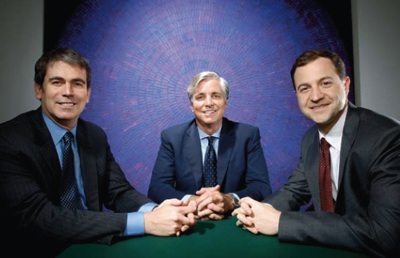The Million Dollar Long Bet
Warren Buffett recently bet an ambitious hedge fund operator $1 million that they won’t beat the returns of S&P 500 after their extremely hefty fees are accounted for. Buffett claims investors will do as well with a no-load index fund over the ten years of the bet. He has long been critical of the performance claims of hedge funds, and his bet is intended to put his money where his mouth is.
Buffett’s million dollar bet was made on Long Bets, the accountability mechanism founded in 2002 by Stewart Brand and myself, and operated by Long Now Foundation. The intention of Long Bets is to encourage responsibility in prediction-making (by keeping a public roster of predictions), to encourage long-term thinking (by offering an opportunity to shape a long-term bet), and to sharpen the logic of forecasting (by recording the logic of predictions and bets.)
In order to make a Long Bet, bettors need to lay out their reasoning. It’s worth reading the two sides’ very short arguments about investing because the two extremes of investment advice are contrasted in them. Buffett, as usual, is stunningly clear in his argument, which ends:
A number of smart people are involved in running hedge funds. But to a great extent their efforts are self-neutralizing, and their IQ will not overcome the costs they impose on investors. Investors, on average and over time, will do better with a low-cost index fund than with a group of funds of funds.
Buffett’s Big Bet is by far the largest bet on Long Bets. The previous largest Long Bet was one for $20,000 between Mitch Kapor and Ray Kurzweil. The two prominent thinkers were betting whether an AI would pass the Turing Test by 2029. Ray was certain an AI would pass muster by then and Kapor was sure it would not get close. (Incidentally, Kapor told me recently he’s willing to double, triple, or quadruple the bet with Ray, or anyone else betting on an AI by 2029.)
The way Long Bets work is complicated. To avoid laws against wagering, the money goes to charities and not to the bettors. Long Bets takes a portion of the growth in assets being held as its own overhead to adjudicate bets in the future. (I am involved with Long Bets but receive no payment from it.)
In the case of the Buffett Big Bet, the arrangement was an immediate contribution to Long Now from both sides of the bet. The details of what is being wagered and how the results are being decided is complex. They are described in great clarity by Carol Loomis a friend of Buffett and senior editor at Fortune. She debuts the Buffett Long Bet in the June 23, 2008 issue of Fortune. (Even though the bet was made on Long Bets in January 2008, we have not posted it publicly until today, as per the wishes of the bettors, who needed to coordinate the announcement and press attention.)
You don’t need a million dollars to make a Long Bet. The minimum wager is $200, and is open to anyone. No money changes hands until someone takes up your challenge. You can also simply make a public prediction, which does not require anyone to bet against you. Any prediction can become a bet later.
The hope of Long Bets is that these public wagers will prompt people to consider the implications of current developments in the near-distant future — and then to keep their attention on what happens.
Buffett’s bet is an ideal Long Bet. It makes a huge difference to anyone who invests in stocks (as do a large percentage of the US, either directly or indirectly) whether a boring index fund yields as much as fancy private hedge funds. The answer either way would be a huge influential signal. When economist Julian Simon won the famous bet against biologist Paul Ehrlich (Simon betting that the long-term prices of commodity minerals would decrease over ten years; Ehrlich betting they would increase), his win essentially eradicated the argument of resource scarcity from the environmental debate. Environmentalists then shifted their concern to the many other issues needed to foster a healthy environment.
This bet has a similar potential. But as in all great bets, its outcome is uncertain. As Loomis writes:
Buffett himself assesses his chances of winning at only 60%, which he grants is less of an edge than he usually likes to have. Protege figures its own probabilities of winning at a heady 85%. Some people will say, of course, that just by making this bet, Protege has acquired some priceless publicity. But then, Protege clearly wants to win, and it’s up against a man who hasn’t made a lot of losing bets in his life. Seides himself sees one strong ray of light: “Fortunately for us, we’re betting against the S&P’s performance, not Buffett’s.”

The other side of Buffett’s bet is being taken by these guys at Protege.


